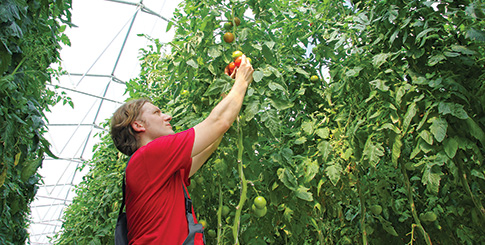Drawing on its advantages as a pioneer and innovator, Ontario is taking protected agriculture to new dimensions in the North American greenhouse capital. Learn how the industry continues to leverage technology to increase yields, broaden product offerings, and maintain high quality—all while besting the inherent challenges of growing perishables.
Greenhouse cultivation in Canada, as well as the rest of the world, continues to gain popularity as consumers demand high-quality produce year-round. With over 165 million square feet devoted to greenhouses, Ontario accounts for over two-thirds of Canada’s output, with an acreage hike of more than 30 percent over the last several years.
Separating Fact from Fallacy
Greenhouse technology is all about controlling the growing environment to optimize production—something conventional growers are unable to do with the seasonal vicissitudes of Mother Nature.
Ray Wowryk, director of business development at NatureFresh Farms Sales, Inc. in Leamington, reiterates the most obvious advantages of greenhouses: not only do they protect plants from outdoor elements like storms, extreme heat, or excessive rain and snow, but “we can control temperature, we can control sunlight, and we can control applications for nutrition, feeding, and watering.”
Greenhouses also avoid possible cross-contamination from nearby field crops, brought by irrigation or animals, or carried by the wind. When added to the scope of integrated pest management techniques, including sophisticated biocontrol agents such as beneficial insects, parasites, or pathogens to keep diseases and pests at bay, there is much to laud about the process. Unfortunately, despite all the pros associated with greenhouse growing, there are a few cons—including general confusion about growing methods and the sterile environment.
Among the more common misconceptions is that seeds used for various crops have been genetically modified. Shalin Khosla, greenhouse vegetable specialist for the Ontario Ministry of Agriculture, Food and Rural Affairs in Harrow, says it’s important for consumers to know seeds are bred traditionally, without genetically modified processes. “People think that because greenhouses are so efficient, they must be doing something different than traditional farming.”
Chris Veillon, chief marketing officer at Pure Hothouse Foods in Leamington, discusses another somewhat surprising downside. He says when people see workers in white hazmat-type suits, they think the worst rather than in the most simple or obvious terms, that the suits protect the crops from outside contaminants. “These plants grow in an environment made just for them,” he stresses, “so we need to maintain certain protocols to respect this optimal growing environment.”



